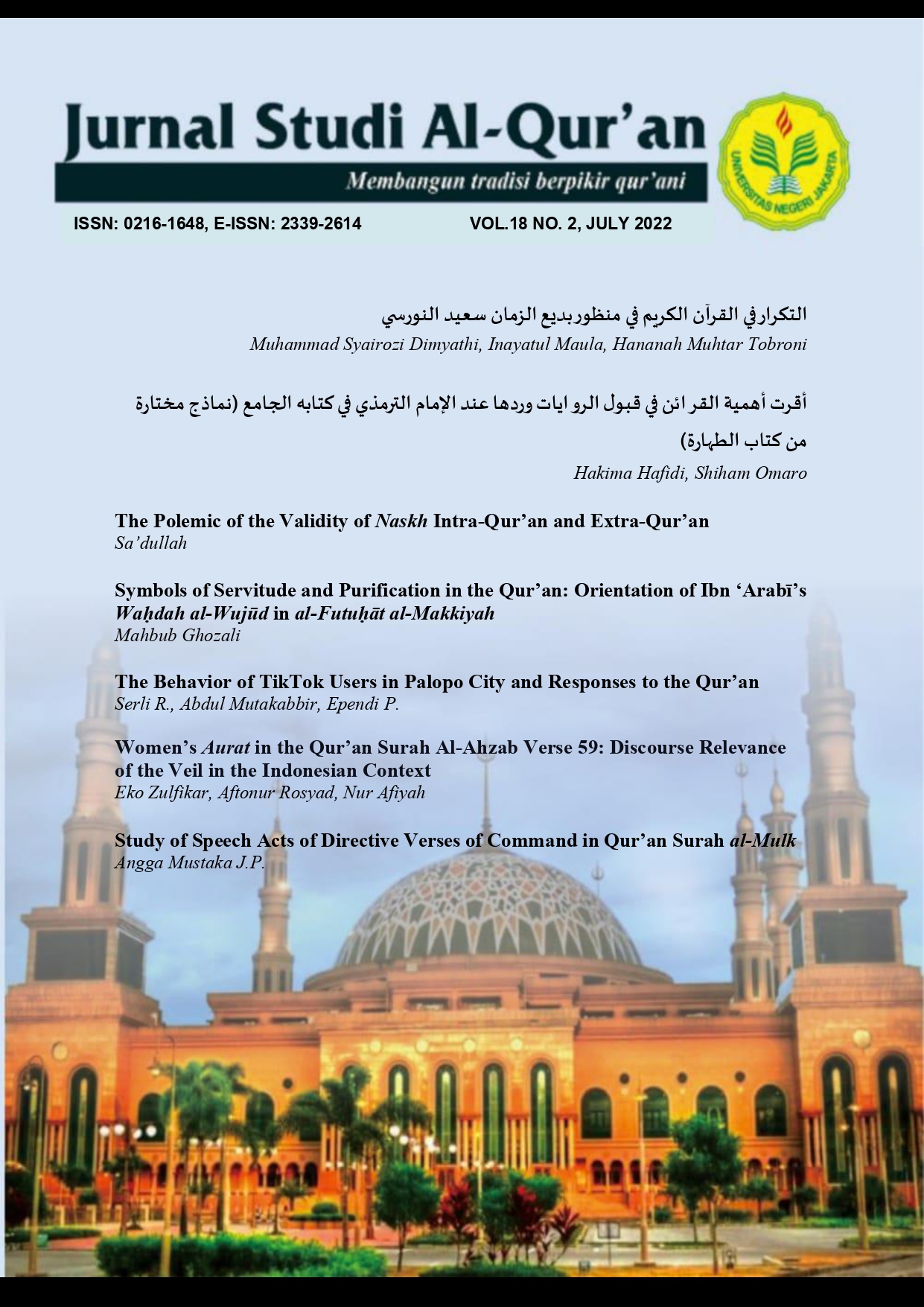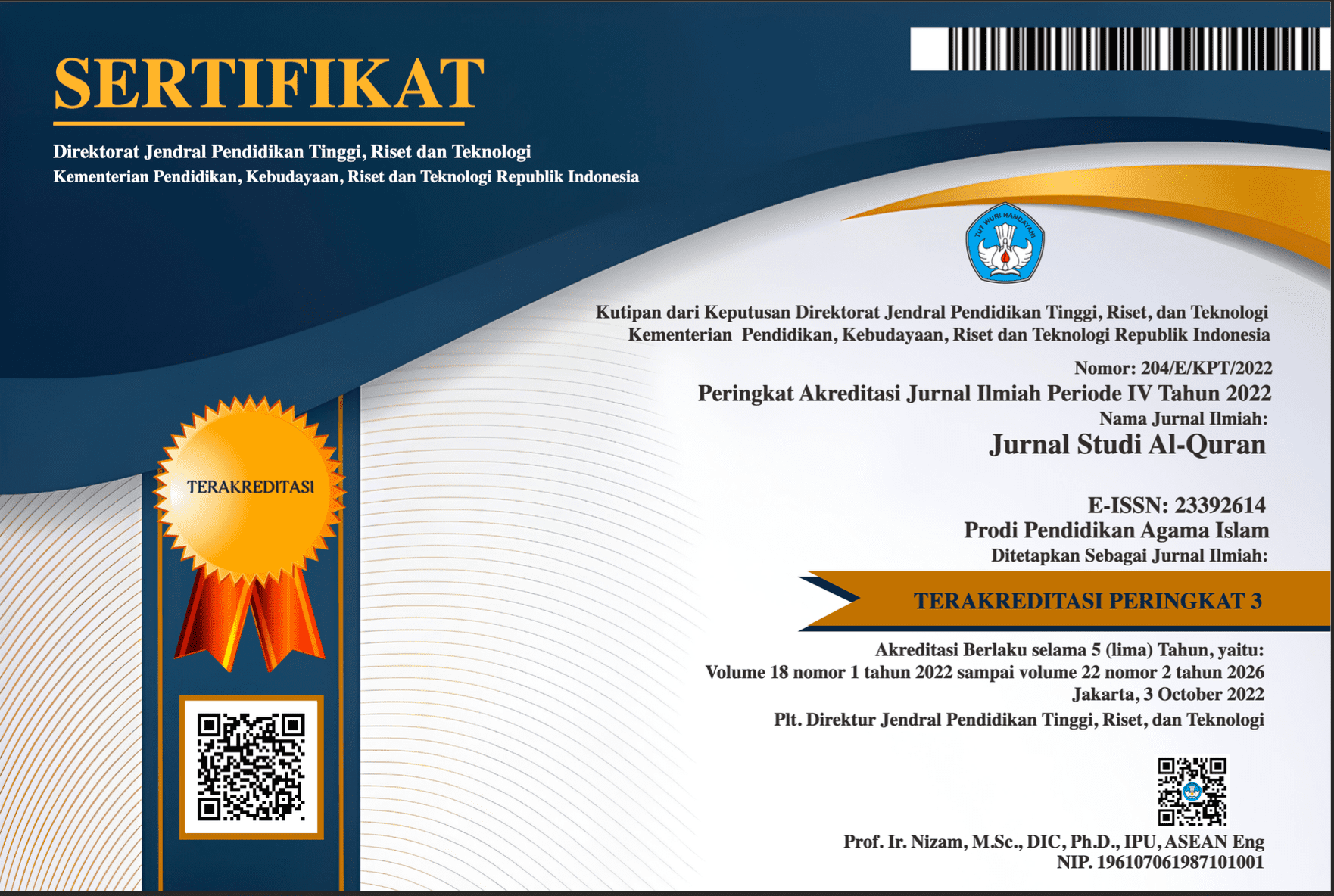Women’s Aurat in the Qur’an Surah Al-Ahzab Verse 59: Discourse Relevance of the Veil in the Indonesian Context
DOI:
https://doi.org/10.21009/JSQ.018.2.06Keywords:
Genital Women, Veil, Indonesia, QS. al-Ahzab verse 59Abstract
This paper explores women's genitalia as far as QS sees it. al-Ahzab [33] verse 59. The specific explanation is related to the use of the veil, which is widespread in the Indonesian context. This study uses a thematic analysis method of the verses of the Qur'an, and it is concluded that there are differences of opinion regarding women's genitalia, especially regarding the face and palms, whether they are classified as aurat or not. This difference then developed in the legal issue of wearing the veil for women. Regarding the use of the veil, scholars consider social conditions so that there are scholars who require women to wear the veil since there has been a lot of slander spread in the community. Some scholars do not require women to wear the veil because the veil is considered a culture that grows from the local culture. However, wearing the veil for women remains relevant in Indonesia because, in addition to the veil protecting women from naughty views of the opposite sex, it will also affect their subconscious to improve religious practices in their lives.
References
Aini, A. N., Nurjanah, E., & Effendi, M. R. (2021). Strategi Menanamkan Nilai-Nilai Akhlak Melalui Integrasi Pendidikan Nilai-Nilai Akhlak Melalui Integrasi Pendidikan. Paedagogie: Jurnal Pendidikan dan studi Islam, 2(01), 32-45.
Al-Anshari, Muhammad bin Ahmad bin Zakariya. Al-Syarqawi ‘ala Syarah al-Tahrir. Jakarta: al-Haramain, 1999.
Al-Baghawi, Abu Muhammad al-Husain bin al-Mas’ud. Ma’allim al-Tanzil - Tafsir al-Baghawi. Beirut: Dar al-Thibah, 1997.
Al-Bantani, Nawawi Muhammad. Nihayat al-Zain. Jakarta: al-Haramain, 1998.
Al-Madzhari, Muhammad al-Utsman. Tafsir al-Madzhari. Beirut: Dar al-Rusydi, 2004.
Al-Mahalli, Jalaluddin dan al-Suyuthi, Jalaluddin. Tafsir al-Jalain. Bierut: Dar al-Hadits, 1995.
Al-Qurthubi, Abu Abdullah Muhammad bin Ahmad al-Anshari. al-Jami’ li Ahkam al-Qur’an. Beirut: Dar al-Alim al-Kutub, 2003.
Al-Shabuni, Muhammad Ali. Mukhtasar Tafsir Ayatil Ahkam. Lirboyo: Dar al-Mubatadi’in, 2017.
Al-Shawi, Ahmad bin Muhammad al-Khalut. Hasyiah al-Shawi ala at-Tafsir al-Jalalain. Beirut: Dar al-Fikr, 2004.
Al-Suyuthi, Jalaluddin. Asybah wa al-Nadzair. Beirut: Dar al-Kutub, al-Ilmiyah, 1998.
Al-Zuhaili, Wahbah. Tafsir al-Munir. Beirut: Dar al-Kutub al-Ilmiyah, 2002.
Anggraeni, D., Hakam, A., Mardhiah, I., & Lubis, Z. (2019). Membangun Peradaban Bangsa Melalui Religiusitas Berbasis Budaya Lokal. Jurnal Studi Al-Qur'an, 15(1), 95-116.
Anggraeni, D., & Suhartinah, S. (2018). Toleransi Antar Umat Beragama Perspektif KH. Ali Mustafa Yaqub. Jurnal Studi Al-Qur'an, 14(1), 59-77.
Effendi, M. R., & Darma, S. H. (2022). The Commodification of Religion in The 2012 Regional Election of Purwakarta Regency. Hayula: Indonesian Journal of Multidisciplinary Islamic Studies, 6(1), 123-150.
Effendi, M. R. (2021). TEOLOGI ISLAM Potret Sejarah dan Perkembangan Pemikiran Mazhab Kalam. Literasi Nusantara.
Fitrotunnisa, Silmi. Hukum Memakai Cadar (Studi Komparatif Terhadap Putusan Hukum Lajnah Bahtsul Masail Nahdlatul Ulama Dengan Majelis Tarjih Dan Tajdid Muhammadiyah). Jurnal Penelitian Medan Agama, Vol. 9, No. 2, Tahun 2018.
Gussevi, S., & Muhfi, N. A. (2021). Tantangan Mendidik Generasi Milenial Muslim di Era Revolusi Industri 4.0. Paedagogie: Jurnal Pendidikan dan studi Islam, 2(01), 46-57.
Hadiyanto, A., Hanafi, Y., Barnannsyah, R. M., Samitri, C., & Ulfah, S. M. (2022). Moderation Patterns of Pesantren in Indonesia: A Study on the Perceptions and Responses of Kyai, Teachers and Santri. Hayula: Indonesian Journal of Multidisciplinary Islamic Studies, 6(1), 81-100.
Hadiyanto, A., & Khumairoh, U. (2018). Makna Simbolik Ayat-Ayat tentang Kiamat dan Kebangkitan dalam Alqur'an. Indonesian Journal of Multidisciplinary Islamic Studies, 2.
Hasan, M. A. K. (2021). The Tafsīr Bi Al-Ma’ṡūr and Bi Al-Ra’yī in The Commentary of Abū Ja’far Al-Ṭaḥāwī. Jurnal Studi Al-Qur'an, 17(2), 179-206.
Ibn ‘Asyur, Muhammad Thahir. al-Tahrir wa al-Tanwir. Bierut: Dar al-Tarikh, 2000.
Ibn Katsir, Abu al-Fida’. Tafsir al-Qur’an al-‘Adzim. Beirut: Dar al-Kutub al-‘Ilmiyah, 1998.
Jum’ah, ‘Ali. al-Niqab 'Adah wa laisa 'Ibadah. Beirut: Dar al-Kutub al-Mishriyah, 2008.
Moleong, J. Lexy. Metodologi Penelitian Kualitatif. Bandung: PT Remaja Rosdakarya, 2005.
Muthahari, Murtadha. Gaya Hidup Wanita Islam, ter. Agus Efendi dan Alwiyah Abdurrahman. Bandung, Mizan, 1990.
Putra, Muh. Yunan. “Cadar, Jenggot dan Terorisme serta Sudut Pandang Ulama Klasik, Kontemporer dan Ulama Indonesia". Sengaji: Jurnal Pemikiran Syariah dan Hukum, Vol. 2, No. 2, 2018.
Sari, N. I., Wajdi, F., & Narulita, S. (2018). Peningkatan spiritualitas melalui wisata religi di makam keramat Kwitang Jakarta. Jurnal Studi Al-Qur'an, 14(1), 44-58.
Sesse, Muhammad Sudirman. Aurat Wanita dan Hukum Menutupnya Menurut Hukum Islam. Jurnal Al-Maiyah, Vol. 9, No. 2, Tahun 2016.
Shihab, M. Quraish. Jilbab Pakaian Wanita Muslimat. Jakarta: Lentera Hati, 2014.
------------------. Tafsir Al-Mishbah: Pesan, Kesan, dan Keserasian Al-Qur'an. Jakarta: Lentera Hati, 2002.
Sudirman, Muh. Cadar Bagi Wanita Muslimah. DIKTUM: Jurnal Syariah dan Hukum, Vol. 17, No. 1, Tahun 2019.
Thantawi, Muhammad Sayyid. Tafsir al-Wasith. Beirut: Dar al-Fikr, 1999.
Tim penyusun, Muasu’ah al-Fiqhiyah. Beirut: Dar al-Fikr, 2005.
Suryabrata, Umadi. Metodologi Penelitian. Jakarta: PT Raja Grafindo Persada, 1998.
Wajdi, F. (2020). Transnational religious movement: The Turkish Süleymanlı in Indonesia. In Routledge International Handbook of Religion in Global Society (pp. 258-267). Routledge.
Wajdi, F., & Aulia, R. N. (2019). Ma ‘had'Aly and the Challenge of Modernizing Islamic Education in Indonesia. Hayula: Indonesian Journal of Multidisciplinary Islamic Studies, 3(2), 173-190.
Downloads
Published
How to Cite
Issue
Section
License
Authors who publish with this Journal agree to the following terms:
- Author retain copyright and grant the journal right of first publication with the work simultaneously licensed under a creative commons attribution licensethat allow others to share the work within an acknowledgement of the work’s authorship and initial publication of this journal.
- Authors are able to enter into separate, additional contractual arrangementfor the non-exclusive distribution of the journal’s published version of the work (e.g. acknowledgement of its initial publication in this journal).
- Authors are permitted and encouraged to post their work online(e.g. in institutional repositories or on their websites) prior to and during the submission process, as it can lead to productive exchanges, as well as earlier and greater citation of published works.
Users/public use of this website will be licensed to CC BY










